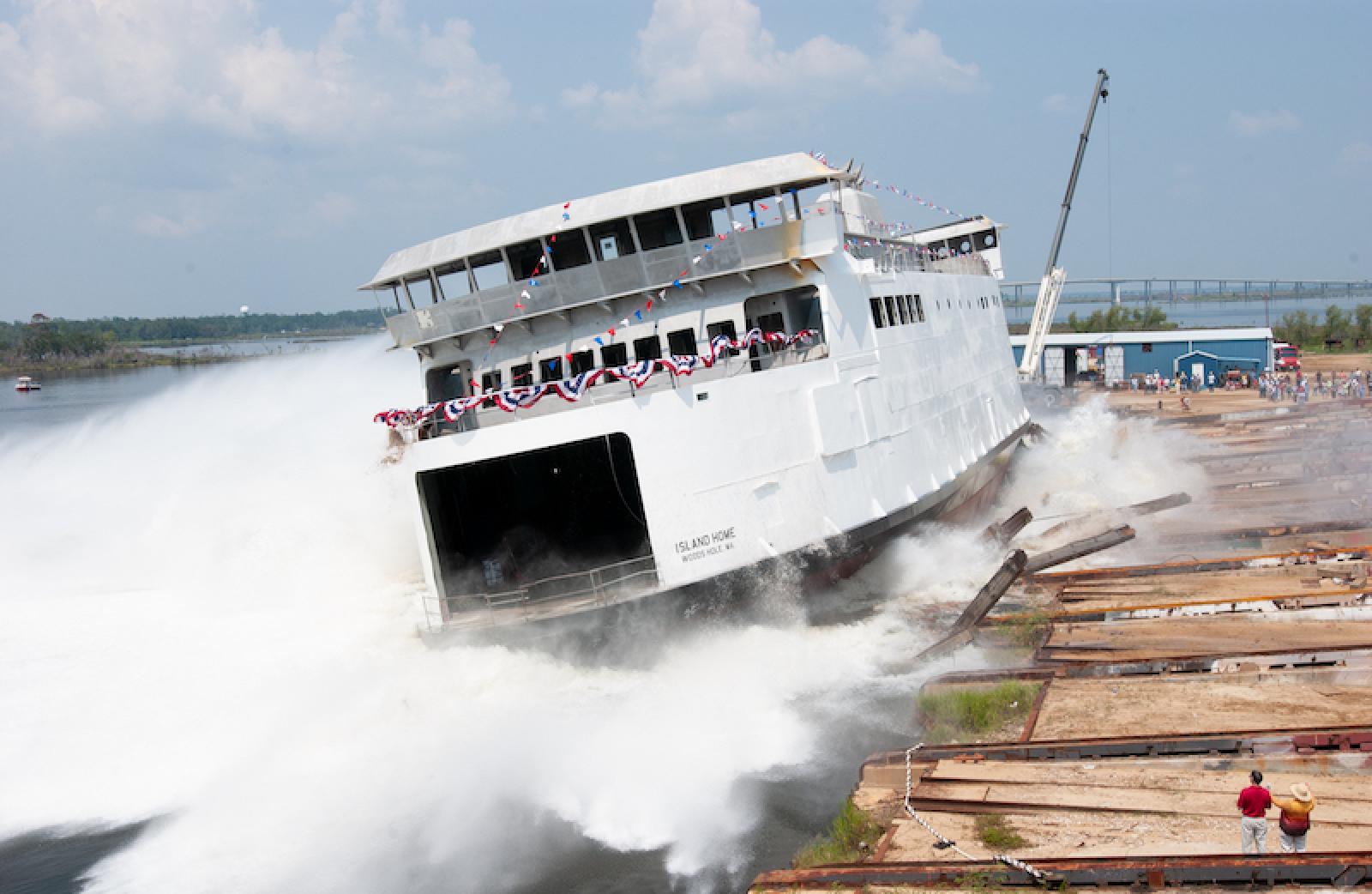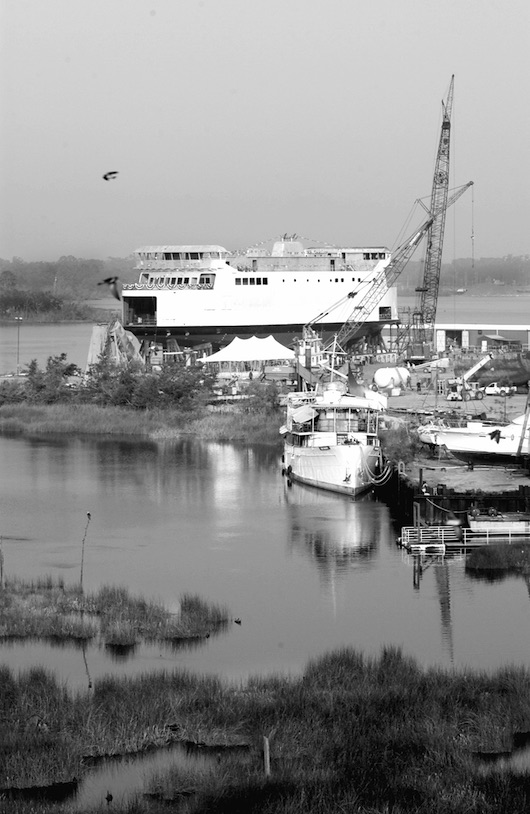MOSS POINT, MISS. - Marking history for the Steamship Authority and its fleet of ferries that ply the routes between the Cape and Islands, the Island Home - a 255-foot, double-ended ferry that will replace the venerable MV Islander - was launched Friday morning at the Gulf Coast shipyard where she was built.
More than 300 onlookers cheered and applauded, with air horns wailing, as the still unfinished vessel - freshly painted black and white - slid sideways on five greased tracks and landed in the calm Escatawpa River with a giant splash.
"That was pretty incredible," said the characteristically understated SSA general manager Wayne Lamson. "To see her now, she looks pretty good."The 11 a.m. (central time) launching took place on a sunny day that was thick with humidity, at VT Halter Marine, the Moss Point, Miss., shipyard where Island Home has been under construction since the spring of 2005. A number of components for the ferry were also built at the VT Halter marine yard in Pascagoula, Miss.
In addition to the team of SSA governors and senior managers who traveled south for the event, many of the shipbuilders themselves attended with their families. The mood was cheerful and upbeat, despite the oppressive heat.
The $31.1 million passenger vessel is still four months from completion and is essentially a shell, with many of the windows on the port and starboard sides yet to be cut. The engine room still lacks hydraulics and wires for the two 3,000 horsepower diesel engines. Forward pilot house windows are cut, but the stern pilot house windows are not.
Work on the 1,630 long-ton vessel came to an abrupt halt last August after Hurricane Katrina roared ashore and wreaked havoc along the Gulf Coast. The work schedule for the project is about five months behind; the ferry is slated to come north in late November and go on line by early January.
The story of Island Home and her launching is tied to a community and a shipyard getting back on its feet after the devastation of a hundred-year storm. "What is very important for us on the Gulf Coast was to get back to a feeling of normalcy," said VT Halter Marine chief executive officer Boyd E. (Butch) King in remarks on Friday morning. He continued: "Island Home is a sense of pride with these shipbuilders. Shipbuilding is not like manufacturing. When you manufacture cars you make thousands of them. Each ship is separate and different. Each one of those fellows knows what seam he welded, what pipe he fitted. There is a feeling of ownership."
A crew of launch specialists attended to the details of their work, loosening and removing the wood timbers that linked the keel to the land below. The Island Home rested on a wood and steel cradle, facing east. Her bow, the anchor end, pointed toward the Route 10 highway bridge. A temporary stage stood near the rudder for the ceremonial christening. Two tall cranes, one with a boom extending 200 feet in the air, removed pallets of gear from the deck, 40 feet above the ground. Diesel engines roared as the cranes lifted the heavy equipment and lowered it to the ground below. Crews aboard the Island Home walked through the vessel and along her deck.

"It is like two boats in one," said Tracy George, a mechanic and maintenance worker, referring to the ferry's double-ended construction. "At each end there is a bow, a rudder, an engine and a propeller. It is like two bows welded together," he said.
For Michael Stringfield, a shipfitter, this was an important day. He had worked on many aspects of the vessel, and with 25 years of building ships under his belt, he expressed affection for the Island Home, saying she was unlike any other ship he had worked on. "For me it is really good to see this all come together," he said.
Before the launch, there were plenty of speeches to mark the occasion.
"What the good people of VT Halter have been through and been able to accomplish over the past year is beyond comprehension," said Falmouth SSA governor and board chairman Robert S. Marshall. "Without having experienced what you went through during last year's storms, certainly none of us will be able to fully understand and appreciate the efforts - the super human effort - that went into getting to where we are today," he added.
Vineyard SSA governor Marc Hanover offered his own words of praise. "This ship is different from any other boat you have ever built. It is not just a ferryboat. It brings all of our supplies, our fuel, food. It is our lifeline to the mainland; for 15,000 year-round residents and 100,000 seasonal residents, and countless millions of tourists," Mr. Hanover said, adding:
"This boat is also a meeting place for Islanders. Picture your day, let us say you work off-Island. You have to ride this boat every day. You have 45 minutes on this boat where there is no television, no background music. You can take a nap, read the paper, socialize with your friends. It is a wonderful place to meet and greet friends and acquaintances. It is an integral part of the social fabric of being an Islander."
He compared the Island Home to the old Islander. "They are both double enders. This is larger and much more passenger friendly. But the concept is still the same. So as you work, understand that this is part of the fabric of the Vineyard life," Mr. Hanover said.
Mr. King then introduced Saralee Marshall, Mr. Marshall's wife, who christened the vessel.
"I would like to say that we are always glad to greet our sponsor. When it comes to the law of the sea, the sponsor gives the ship its personality. And I can tell you now, with what Marc just said, I think Saralee is the perfect choice; raising two kids and grandkids, she can handle anything. And that is what we think Island Home will do also," Mr. King said.
He escorted Mrs. Marshall near the place where the freshly painted red rudder hung. She swung a champagne bottle with two hands and it exploded in a shower of bubbly liquid.
Then the ship began its slide down the guides, accompanied by the brief sound of wood crumbling under the shifting weight. Horns sounded. Voices cheered and hands clapped.
And the Island Home landed with a splash.
Once she was in, two tugboats pushed the vessel to an adjoining dock.
Mrs. Marshall expressed her appreciation for the moment. "When you see it unfinished, you see how much work really goes into it," she said.
Shipyard project manager John Carnley noted the ferry is the sum of many parts. The steel came from mills throughout the country, including in Alabama and West Virginia. The steel shaft for the propellers was forged in Pennsylvania. The aluminum came from overseas and was processed in Mississippi mills. Fiberglass tanks came from New England. The two propellers came from Rolls-Royce of Mississippi. The rudder and reduction gear for the engines are from Germany. The bow thruster is from England. Heating and air conditioning systems will come from Canada. Seats and tables will come from Australia. The two pilot house consoles, yet to be installed, will come from Seattle, Wash. Fire suppression equipment comes from Louisiana.
"The pieces come from all over the world," agreed Carl R. Walker, director of engineering and maintenance for the boat line. For Mr. Walker, the project to build the Island Home goes back a good number of years, beginning with early discussions around a table in Woods Hole in 2003.
After the launch, guests gathered for a Southern-style chicken barbecue, hosted by the SSA and held in one of the shipyard's oversized sheds. Fans mounted on the corner of the facility kept the air moving.
The meal was served a few hundred feet from the bow and parts of the shipyard's next vessel, a 208-foot fisheries research vessel for the National Oceanic Atmospheric Administration, called Pisces.
The afternoon ended with another walk through the vessel by representatives from the boat line.
With his grandson holding his hand, Mr. Carnley walked aboard the ship for the tour. The effort now shifts, he said. "This is the busiest time. This is when you get all the systems working, when you do the sea trials."
Island Home will be delivered to the SSA Fairhaven wharf by Nov. 29. She is scheduled to go into service by Jan. 3.








Comments
Comment policy »